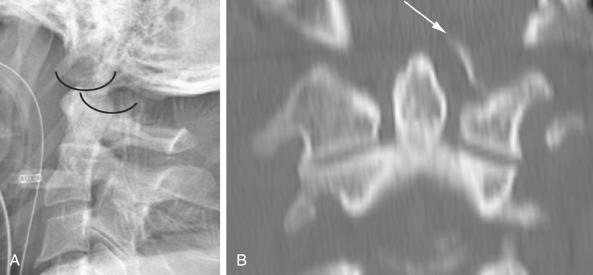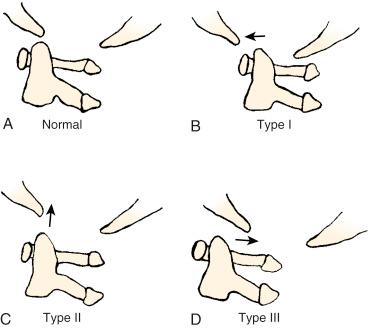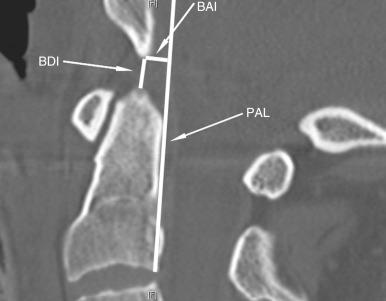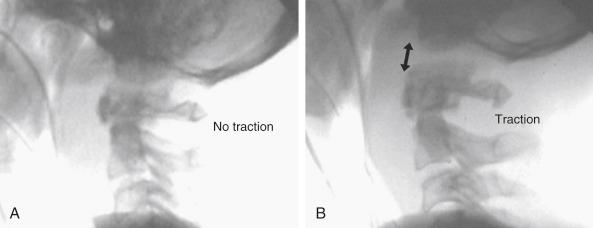Physical Address
304 North Cardinal St.
Dorchester Center, MA 02124
|
|
|
|
|
|
|
|
The occipitocervical junction consists of structurally important osseous and ligamentous complexes that stabilize the skull base to the spine and encase vital neurovascular structures.
The high susceptibility of the occipitocervical junction to traumatic injury is largely related to the lever arm forces of the spine on the immobile skull base combined with a reliance on ligamentous rather than bony structures for stability.
This complex anatomic arrangement is maintained by specialized C1 and C2 bony segments interconnected by an incompletely understood ligamentous system that, if compromised, places the structural integrity of the occipitocervical junction at risk.
Because of the proximity of neurovascular structures, sudden loss of occipitocervical structural integrity carries a high mortality. However, improved trauma care has dramatically increased the likelihood of survival and has shifted the burden of responsibility to the spine surgeon for appropriate diagnosis and treatment of such life-threatening injuries.
This chapter focuses primarily on six upper cervical fracture types, which may coexist: (1) occipital condyle fractures, (2) occipitocervical dissociation, (3) fractures of the atlas (C1), (4) C1-C2 instability patterns, (5) odontoid (C2) fractures, and (6) traumatic spondylolisthesis (hangman fracture) of C2.
Although often stable, occipital condyle fractures may be highly unstable if they are associated with bony avulsion of major craniocervical stabilizers. Anderson and Montesano described the following classification system distinguishing mainly bony involvement, as opposed to more ligamentous involvement ( Fig. 17-1 ) :
Type I: Stable, comminuted axial loading injuries
Type II: Potentially unstable injuries caused by a shear mechanism that result in an oblique fracture extending from the condyle into the skull base
Type III: Unstable alar ligament avulsion fractures that result in a transverse fracture of the occipital condyle and may represent a component of occipitocervical dissociation

Lower amount of fracture displacement, greater degree of apposition, and larger fragment size have been proposed as criteria for healing of occipital condylar fractures. Overall, occipital condyle fractures are usually benign. Nonetheless, any occipital condyle fracture should be considered a possible component of occipitocervical dissociation.
Occipital condyle fractures are difficult to visualize on plain radiographs. They are most easily characterized with computed tomography (CT) imaging. Magnetic resonance imaging (MRI) plays a role primarily in establishing whether type III odontoid fractures are associated with extensive ligamentous injury and occipitocervical instability.
Operative treatment of occipital condyle fractures is generally reserved for type III injuries that represent alar ligament avulsions and result in occipitocervical instability ( Fig. 17-2 ). Surgical indications are therefore equivalent to those described later for occipitocervical dissociation ( Table 17-1 ).

| Injury Type | Distinguishing Characteristics | Significance and Treatment |
|---|---|---|
| I | Comminuted fracture | Usually stable injury treated with cervical collar or possibly halo vest for severe collapse |
| II | Extension of basilar skull fracture | Cervical collar unless associated with occipitocervical dissociation |
| III | Avulsion fracture of alar ligament insertion | Cervical collar unless associated with occipitocervical dissociation |
Type I and most type II occipital condyle fractures are treated nonoperatively, with a rigid cervical collar. Because type I injuries can result in considerable articular incongruity, the outcome often depends on the presence or absence of symptomatic posttraumatic arthritis, which may result in neck pain, occipital headaches, restricted occipitocervical motion, and torticollis. Palsy of closely associated cranial nerves (IX, X, XI, XII) has also been described. Type II and isolated type III injuries generally pose less risk of posttraumatic arthritis because of the lower likelihood of articular incongruity. However, if these injuries are components of craniocervical or occipitocervical dissociation, the prognosis is worse (see later).
Traynelis and associates identified three occipitocervical dissociation patterns based on the direction of displacement of the occiput relative to the cervical spine ( Fig. 17-3 ). However, the extreme instability of these injuries renders the position of the head relative to the neck completely arbitrary and more dependent on external forces than on any intrinsic injury characteristic. A directionally based classification therefore seems to have little inherent value.

A classification that reflects injury severity and quantifies the stability of the occipitocervical junction would provide greater clinical significance with regard to treatment and prognosis. Signs of instability are translation or distraction of more than 2 mm in any plane, neurologic injury, and concomitant cerebrovascular trauma. However, patients with minimally displaced occipitocervical injuries may have less easily recognized unstable occipitocervical dissociative injuries and therefore must be segregated into the following two groups: (1) patients with relatively stable injuries who can be treated nonoperatively and (2) patients with highly unstable but partially reduced injuries who require operative stabilization in spite of a misleadingly low degree of displacement. Distinguishing between these two possible clinical situations by the use of manual traction testing (see later) can be useful in patients with minimally displaced injuries with evidence of extensive occipitocervical injury (ligamentous injury, soft tissue swelling, neurologic or cerebrovascular abnormalities). Surgical stabilization can be reserved for patients with type II and III injuries of the occipitocervical junction, which are defined as dissociations according to the Harborview classification system ( Table 17-2 ).
| Stage | Description of Injury |
|---|---|
| 1 | MRI evidence of injury to craniocervical osseoligamentous stabilizers Craniocervical alignment within 2 mm of normal Distraction of ≤2 mm on provocative traction radiograph |
| 2 ∗ | MRI evidence of injury to craniocervical osseoligamentous stabilizers Craniocervical alignment within 2 mm of normal Distraction of >2 mm on provocative traction radiograph |
| 3 ∗ | Craniocervical malalignment of >2 mm on static radiographic studies |
∗ These injuries are defined as craniocervical dissociation.
Injuries to the upper cervical spine are notoriously difficult to detect with plain radiographs, for several reasons. Because the x-ray beam is directed toward the midcervical spine, the parallax effect at the occipitocervical junction precludes proper visualization of the upper cervical articulations. Other structures, such as the mastoid air cells, may also obscure the relevant upper cervical anatomy. Because of the rarity of occipitocervical injuries relative to other types of cervical spine injuries, decreased vigilance is also likely to be a factor.
Various radiographic lines have been established in an attempt to measure occipitocervical alignment indirectly. Of these, the Harris lines have been the most useful in helping to identify occipitocervical dissociation injuries ( Fig. 17-4 ). Either a basion-dens interval (BDI) or a basion-axial interval (BAI) greater than 12 mm is highly likely to represent an occipitocervical distraction injury. These lines are not as specific as they are sensitive, and a study demonstrated that one third of patients in a series of 48 consecutive survivors of occipitocervical dissociation had normal BAI and BDI values. An additional clue may be provided by examining the soft tissue shadows because patients with occipitocervical dissociation invariably have a large amount of soft tissue injury and extensive prevertebral swelling extending up to the occipitocervical junction.

CT, now commonly used as a routine screening test for cervical spine injury, also allows for more accurate Harris line measurements and has the advantage of enabling the examiner to visualize the occipitocervical and atlantoaxial joints directly to assess for subluxation. Even the slightest asymmetry or distraction of the atlanto-occipital joints should be viewed with suspicion because these joints usually have a displacement tolerance of 2 mm or less.
An additional clue to the presence of an unstable occipitocervical injury can be provided by detecting avulsion fractures of the alar ligament, which along with the tectorial membrane, serves as one of the two primary stabilizers of the occipitocervical junction. These avulsion fractures generally consist of bony avulsions from the origin of the alar ligament on the inferomedial aspect of the occipital condyle and are classified as type III occipital condyle fractures according the classification of Anderson and Montesano (see Fig. 17-1 ). Avulsion fractures may also occur at the alar ligament insertion on the odontoid process and are classified as type I odontoid fractures according to Anderson and D’Alonzo.
Distraction is often seen at both the occiput-C1 and C1-C2 joints because the primary stabilizers of the occipitocervical junction extend from the occiput to C2. Highly unstable occipitocervical injuries can have an unsettlingly benign appearance on CT imaging. Once again, extensive soft tissue swelling can generally be seen on CT evaluation and should provide an important clue. Any finding suggestive of a significant occipitocervical injury should be further evaluated with MRI.
MRI generally demonstrates increased T2-weighted signal intensity within the occiput-C1 and C1-C2 articulations. Definitive evidence of disruption of the alar and tectorial ligaments can sometimes be seen, although making this determination may be difficult. Evaluation of the spinal cord and brainstem parenchyma may reveal injuries ranging from mild edema and increased T2-weighted signal intensity to the presence of intraspinal hematoma or even transection. Epidural fluid collections representing hematoma or cerebrospinal fluid are commonly seen, as is the presence of subdural hematoma. Extensive soft tissue swelling extending to the occipitocervical finding is a universal finding and is easily identified on MRI.
Evaluation of a large series of survivors of occipitocervical dissociation demonstrated a high likelihood of vertebral artery or internal carotid injury with occipitocervical distractive injury; this combination affected approximately two thirds of patients. Although most of these injuries among survivors were thought to be asymptomatic, prior knowledge of an existing vascular injury may help dictate perioperative management of the patient or the fixation strategy used for definitive stabilization. For example, the surgeon may consider the use of lower-risk C2 fixation, such as the use of translaminar screws, if preoperative vascular evaluation suggests the presence of contralateral vertebral artery compromise. The treatment of asymptomatic vascular injuries in this region remains controversial, with proponents for observation alone, for aspirin therapy, and for anticoagulation with warfarin.
Traction views under specific, controlled conditions have been advocated by some investigators for a selected group of patients in whom the diagnosis of occipitocervical dissociation is uncertain. Although these patients have generally been identified as having upper cervical spine injuries, they are generally noted to have minimal displacement of the occiput-C1-C2 articulations with only equivocal evidence of true occipitocervical dissociation.
The authors’ preference is to perform traction testing in the operating room by using live fluoroscopic evaluation with electrodiagnostic monitoring. This test is treated as a precursor to definitive fixation. Therefore, the patient is given general anesthesia, with preparations made to proceed with posterior occipitocervical fixation in the event of a positive test result. Mayfield or Gardner-Wells tongs are applied after baseline electrodiagnostic signals have been obtained. The C-arm is oriented to obtain a true lateral view of the upper cervical spine. Guided by live fluoroscopy, the surgeon applies gradually increasing manual traction to the cranial tongs. Some surgeons prefer applying progressive 5-pound weights to the tongs, but manual traction provides important proprioceptive feedback.
Whether a traction test result is negative or positive is not usually in question. With a negative test result, a firm end point is felt almost immediately by the surgeon performing the distraction. Progressively greater amounts of traction cause only minimal distraction of no greater than 2 mm. The occipitocervical junction is therefore deemed stable, and surgical intervention is aborted in favor of treatment with external immobilization.
In the event of a positive test result, distraction greater than 2 mm occurs quickly and with minimal traction. No semblance of an end point can be detected by the surgeon applying traction. Obviously, continuing the distraction beyond the minimum necessary required to demonstrate occipitocervical instability has little value. Once occipitocervical dissociation is confirmed, the surgeon proceeds with posterior occipitocervical instrumented arthrodesis.
Displacement of greater than 2 mm at the atlanto-occipital joint, either on static imaging studies or with provocative traction testing ( Fig. 17-5 ; see Table 17-2 ), and the presence of neurologic injury are indications for occipitocervical stabilization. Particularly in the presence of neurologic deficits, stabilization is performed as early as reasonably possible.

Because occipitocervical dissociation is fatal in most cases, few meaningful descriptions of treatment results are available. More recent series suggest that one of the primary challenges is to make an accurate and timely diagnosis; reports note delayed diagnosis in 30% to 50% of patients and a higher likelihood of preoperative neurologic worsening in patients with diagnostic delay. Once the diagnosis has been confirmed, the focus is shifted toward provisional stabilization until definitive surgical intervention can be performed.
The most appropriate form of provisional stabilization is controversial and depends on many factors, including the timing of surgery, the degree of initial displacement, and the patient’s neurologic status, body habitus, and associated injuries. Possible options include one or more of the following: rigid cervical collar immobilization; halo immobilization; taping of the head to sandbags on both sides; and the use of Trendelenburg positioning, if tolerated, to minimize distraction. Finally, definitive surgical intervention generally consists of posterior occipitocervical instrumented fusion, which is done as early as reasonably possible, taking into account the patient’s physiologic condition.
Posterior occipitocervical fixation, extending from the occiput to at least C2, is the definitive treatment for occipitocervical dissociation. The authors recommend the use of electrodiagnostic monitoring with prepositioning baselines and the use of Mayfield tongs for turning patients with this highly unstable injury into the prone position. Rigid craniocervical fusion techniques using screw and plate constructs with suboccipital- and sublaminar-cabled structural graft have resulted in fusion rates approaching 100%; the largest reported series of patients treated in this manner showed no incidence of hardware failure or need for revision surgical procedures for reasons of instability. Potential technical problems include the following: malreduction, which may result in neurologic worsening; possible penetration of the inner cortex of the skull, which can lead to injury to neural or vascular structures; and vertebral artery injury.
Treatment outcomes in survivors of occipitocervical dissociation depend on the type and severity of associated injuries (particularly intracranial injuries and cerebrovascular injury), the severity of neurologic deficits, and the timeliness with which the diagnosis of craniocervical dissociation is recognized and treated.
Atlas fractures (C1) can occur in isolation or in conjunction with other injuries, typically of the axis, in 40% to 44% of cases. Instability invariably equates with the presence of transverse alar ligament (TAL) insufficiency, which can be diagnosed either by direct means, such as by identifying bony avulsion on CT scan or ligament rupture on MRI, or indirectly by identifying widening of the lateral masses with a 7-mm or greater lateral overhang relative to the lateral masses of C2 on the open-mouth anteroposterior (AP) view on plain radiographs ( Fig. 17-6 ).

Levine and Edwards described a useful four-part classification system: (1) posterior arch fractures, (2) lateral mass fractures, (3) isolated anterior arch fractures, and (4) bursting-type fractures. As mentioned earlier, the extent of lateral mass separation, which reflects the integrity of the TAL, is more relevant than the number of fracture fragments.
Particular fracture orientations within the fracture subdivisions described by Levine and Edwards can manifest in an atypical fashion. Although the horizontal anterior arch fractures of C1 are typically stable, Vilela and co-workers reported a series of five atypical cases in which this fracture was a subtle sign of more severe occipitocervical instability. Bransford and associates also reported that patients with sagittally oriented unilateral lateral mass fractures are at risk of delayed deformity and severe pain. The authors show good results with the technique of direct fixation of the C1 ring for stabilization of these fractures ( Fig. 17-7 ).

Become a Clinical Tree membership for Full access and enjoy Unlimited articles
If you are a member. Log in here